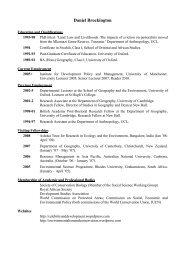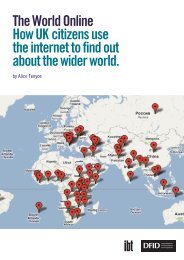World
Viewing the world - Full report
Viewing the world - Full report
- No tags were found...
You also want an ePaper? Increase the reach of your titles
YUMPU automatically turns print PDFs into web optimized ePapers that Google loves.
half an hour and was shown at 1700 and 0130. While thefocus of the programme was the archaeology of the LostCity, much of the discussion concerned the level ofdestruction caused by colonialists over the past century,and the reasons for their attempts to claim the city as awestern construction. The programme includedinterviews with archaeologists, film of the Lost City andstills of paintings. This documentary began byexplaining that ‘racist colonisers’ had claimed the cityhad biblical or European origins, in order to justify itsplunder and their savage treatment of local people. Thenarrator John Rhys-Davies introduced the programme:A mysterious ruin in the heart of Southern Africa,proclaimed by racist colonisers to be the work of anancient white civilisation. Stripped by ignorance andprejudice of its priceless artefacts, is it too late to unlockthe secrets of Great Zimbabwe.The white archaeologist who appeared throughoutmuch of the Time Travellers explained further:The fact that the ruined complexes in Southern Africawere supposed to be of biblical origin was very convenientto the Afrikaaners. It gave the historical precedent forcolonisation, and in a sort of double whammy gave themalso a biblical sanction for the colonisation andexploitation of Africans.Of Cecil Rhodes’ determination to prove GreatZimbabwe was the capital of an ancient Venetiansettlement, he commented:And he did so because he was interested in establishingforeign origins for these sites, again as a justification forthe use of Africans as cheaper mine labour, which was hismain objective because he now controlled the originalgold mines in the area. The interesting sideline to this wasthat the African miners had been far too efficient, and thegold deposits in that area were largely exhausted by thetime the whites got control of the area.What is significant about the documentary is that itexposes the extent to which positive concepts of Africancivilisation were suppressed and distorted so thatnegative images could be promoted, in the interest ofcolonisation. The other important feature was that blackZimbabwean archaeologists began to feature in the latterpart of the programme. The white archaeologist who hadexplained the archaeological history of Great Zimbabwecommented:What is important is that now, for the first time in the lastten to fifteen years, a body of African students arebeginning to learn archaeological techniques and applytheir own intimate understandings of African culture forAfrican archaeological sites, not only in Zimbabwe butalso in surrounding African countries.Black African archaeology students were filmedexamining the site and inspecting stonework from thesite under microscopes. One black archaeologist inparticular was interviewed about white attitudes towardsthe Shona people who inhabited old Zimbabwe:This was a time when people had a very backward viewabout African civilisation. What is surprising about evenduring the UDI days – the days of Ian Smith – we findthat they try to discredit the connection between GreatZimbabwe and the Africans.The head of Rhodesia’s antiquities departmentresigned in 1971, after receiving a diktat from IanSmith’s breakaway white government, forbidding anymention of the true origins of the ruins in the officialguidebook. A picture of the old guidebook was shown onscreen, depicting a black African bowing before theforeign power.In 1980, after a bloody civil war, the government ofRhodesia came under black majority rule. Finally thepeople of Zimbabwe were free to search for their pastamong the ruins from which the newly independentcountry had taken its name.DISCUSSIONMost of the programmes on developing countries in theone week sample of Discovery were travel/adventureseries. These travelogues were similar in the type ofimagery they presented, particularly in Africa, wheresafari or the tracking and killing of wildlife featured in allfive programmes. However there were variations in thestyle and content of these programmes, ranging from thepicturesque but less informative travelogues such asWalkers <strong>World</strong> to the more adventurous and pioneeringstyle of Trailblazers. Most of the travelogues relied onspectacular depictions of scenery and/or the closestpossible views of wildlife, the rarer the better. This wastrue of Walkers <strong>World</strong>, Nick’s Quest, Danger Zone and GreatEscapes, where there were limited references to the socialcontext of the countries, or to the lives of local people.Having said this, local people who featured in theseprogrammes were at least introduced by name to theviewer and Nick’s Quest involved the search for a blackAfrican conservationist and expert, which was rarely thecase elsewhere in our sample.Compared to mainstream terrestrial holiday shows,they generally presented more positive images of localpeople in developing countries. This was particularlytrue of A River Somewhere and the two editions of120 DFID – July 2000





